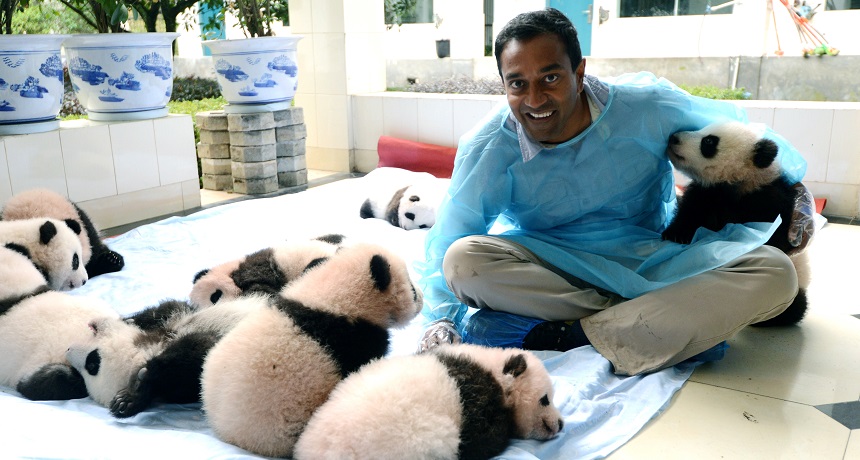Nature documentary puts people in the picture
New television series how we can live with, and not just off of, our environments

Seen here with baby pandas, M. Sanjayan shows how people can live alongside their environments, rather than trampling over them.
Ami Vitale/Passion Pictures
A class trip to the Amazon may be out of the question, but a good documentary can bring those far off landscapes to life. Schools of glossy fish, lions on the hunt and pandas trundling through forests offer a more realistic picture than even a trip to the zoo or aquarium.
But an important species often has been missing from these inspiring landscapes: people. A new nature show wants to rectify the omission. Earth: A New Wild will begin airing on PBS at 9 p.m. (8 central time) beginning February 5. The five-part series aims to show how people are just as much a part of the environment as are the wildlife.
“The wilds of planet Earth are spectacular,” says M. Sanjayan. He is a conservation biologist and host of the new series. “Yet one species is always missing from the picture: us.”
While many nature documentaries only show animals interacting with each other, this one depicts how people live in -and with -their environments. From tribes in the Amazon to abandoned boats in the former Aral Sea, Sanjayan shows viewers the different ways in which people have disrupted ecosystems -but also how such ecosystems might be saved.
Sanjayan is a friendly and enthusiastic guide to each hour-long episode. Three focus on ecosystems — oceans, forests and plains. The other two focus on fresh water and home, a catchall for how people attempt to control their interactions with the natural world around them.
How people alter wild lands can be obvious. For instance, Sanjayan attempts to follow the Colorado River to the ocean. Along the way, he discovers that people have used up all the water. The river never meets the ocean at all. Other times, those human-induced changes are subtle. You might assume that fewer herds of cattle, wildebeest or elephants would mean that local grasslands will flourish. But Sanjayan shows that grasslands depend on their grazers. Without them, fertile plains become deserts.
The episodes often tell several stories. The pacing is brisk. Most tales flow together, but the forest episode is unfortunately jerky and a bit hard to follow. With too many tales to tell, questions end up asked and never answered. People concerned about nudity may also wish to bypass parts of this episode, as the people featured are sometimes in traditional dress (or undress, by Western standards). This could produce some giggling in the younger grades.
But the series’ beautiful footage of people and animals should keep audiences enthralled. The tone is hopeful. Sanjayan focuses on people and organizations that are trying to work with their environments, not against them. In the end, the viewer comes away with a sense not only of how big beasts live in the wild, but also of how billions of us can sustainably coexist with them.
Earth: A New Wild premieres February 4 at 9/8c on PBS.
Produced by National Geographic Television with Passion Planet Production.
Follow Eureka! Lab on Twitter
Power Words
ecosystem A group of interacting living organisms — including microorganisms, plants and animals — and their physical environment within a particular climate. Examples include tropical reefs, rainforests, alpine meadows and polar tundra.







